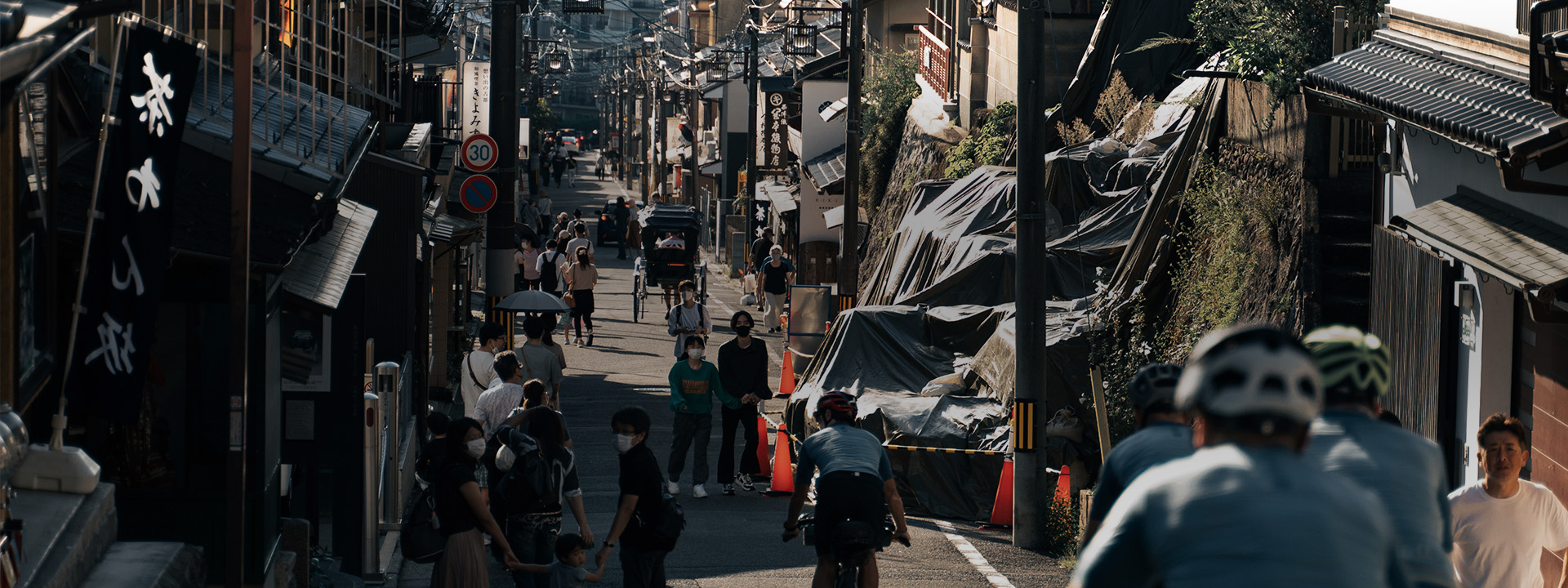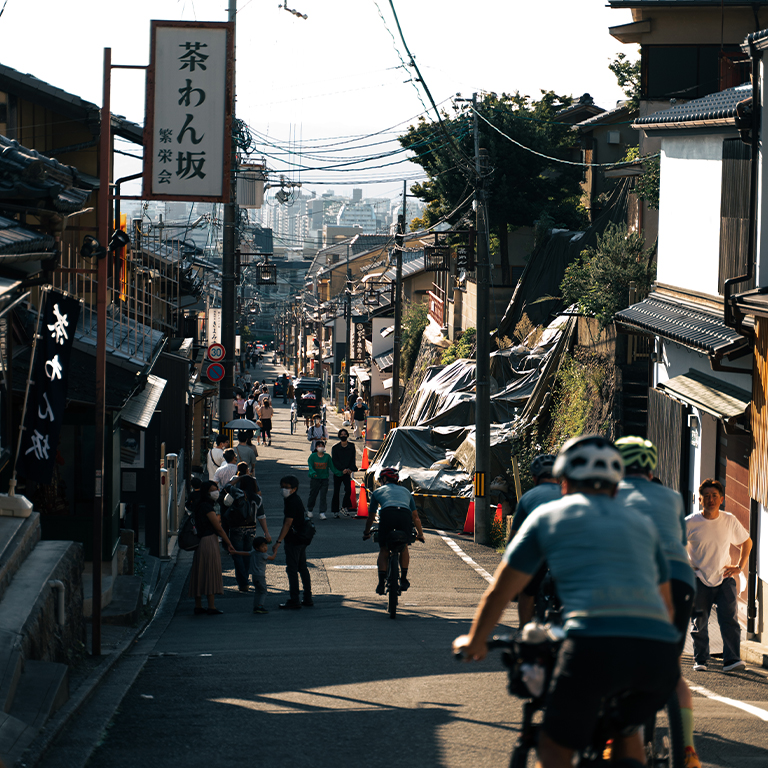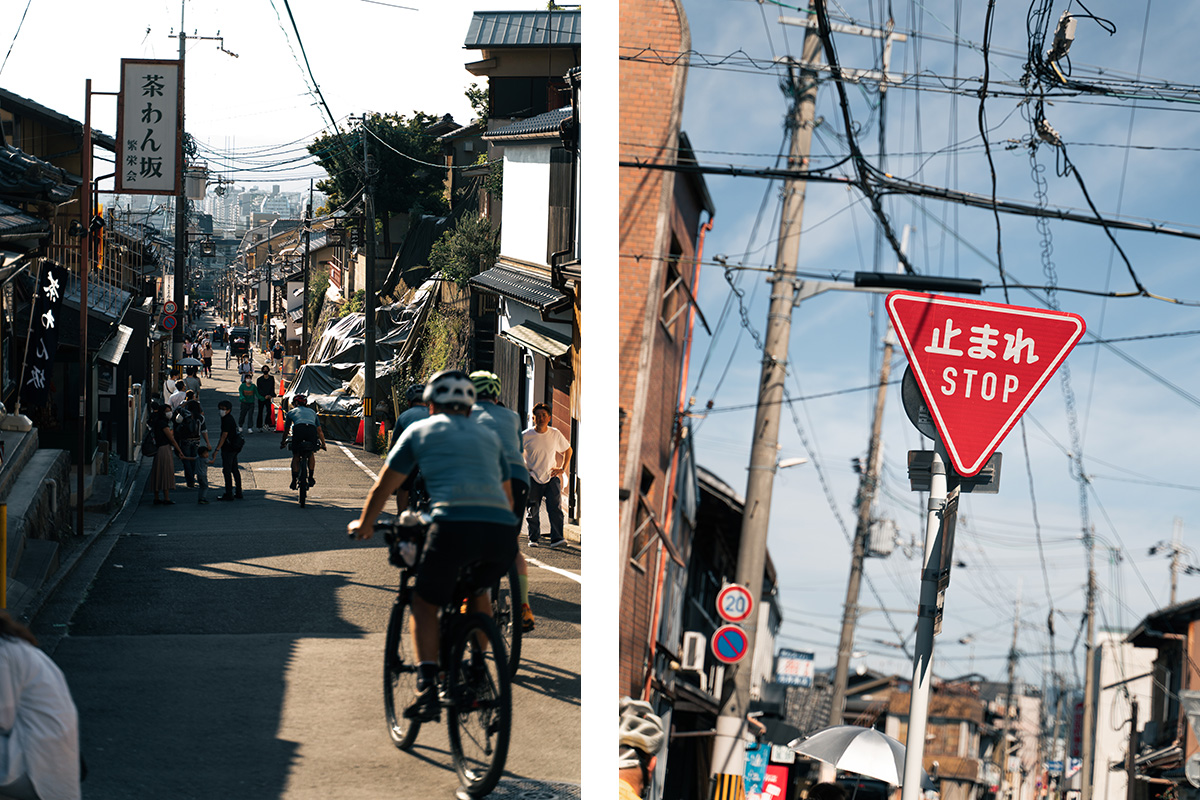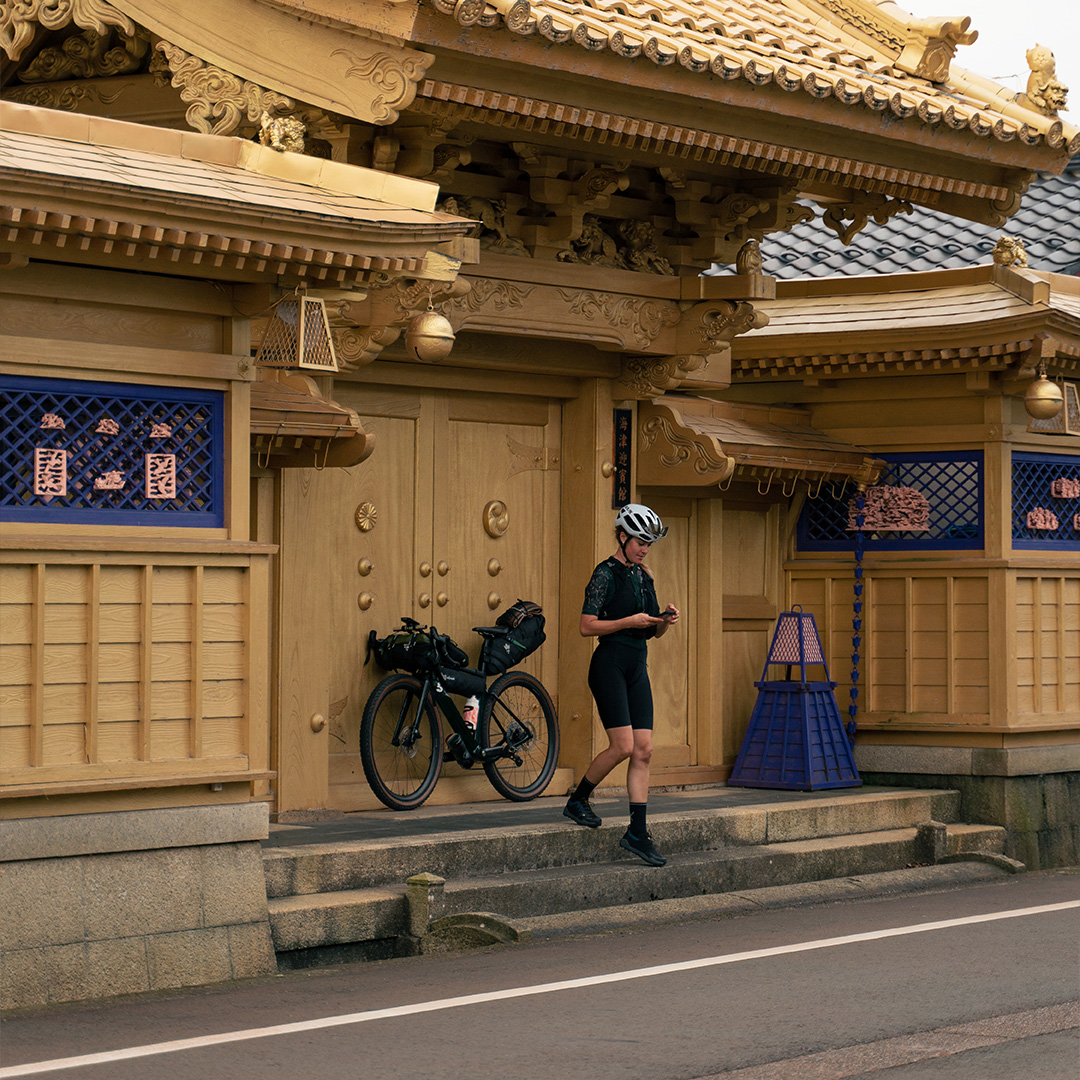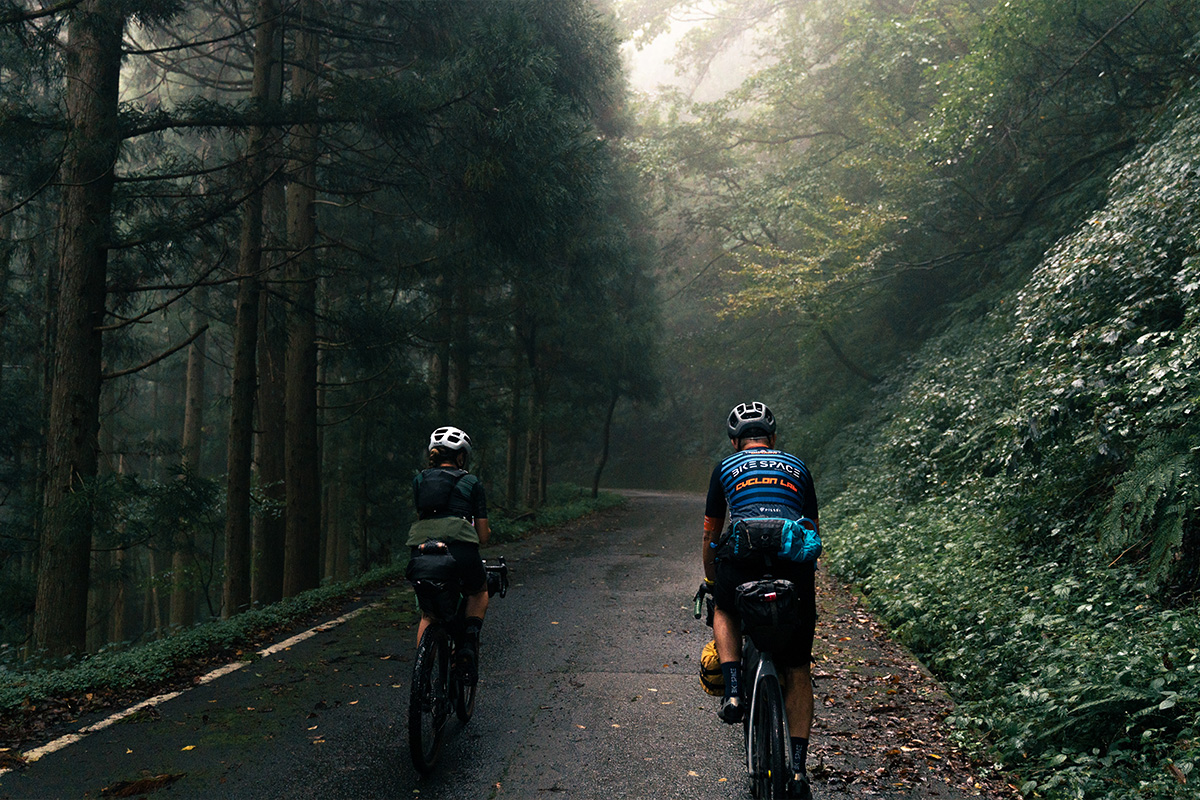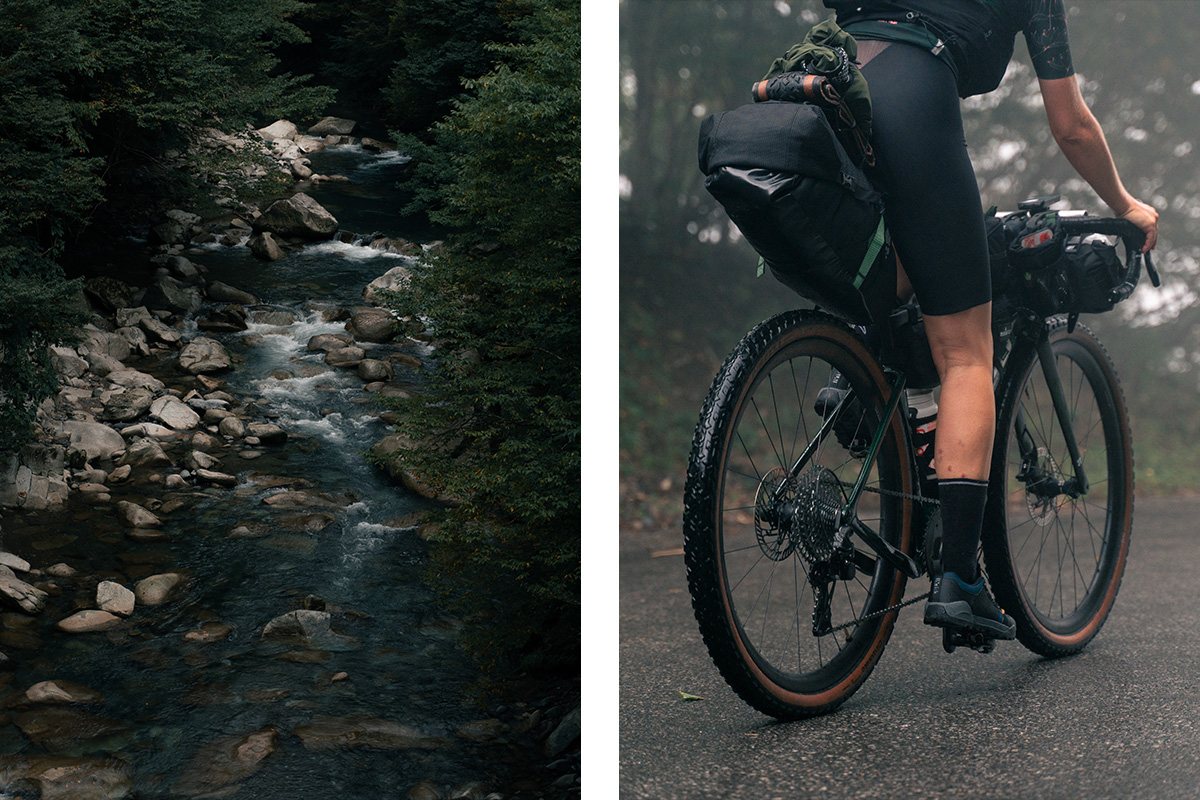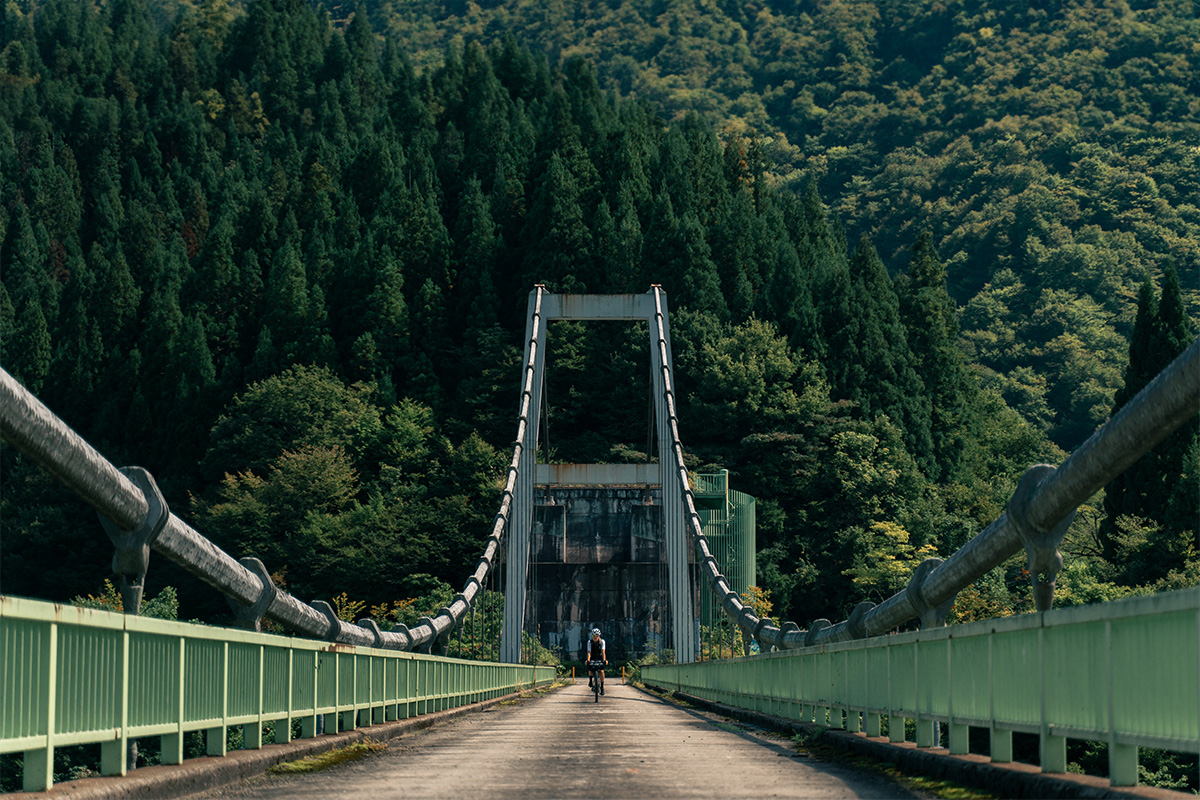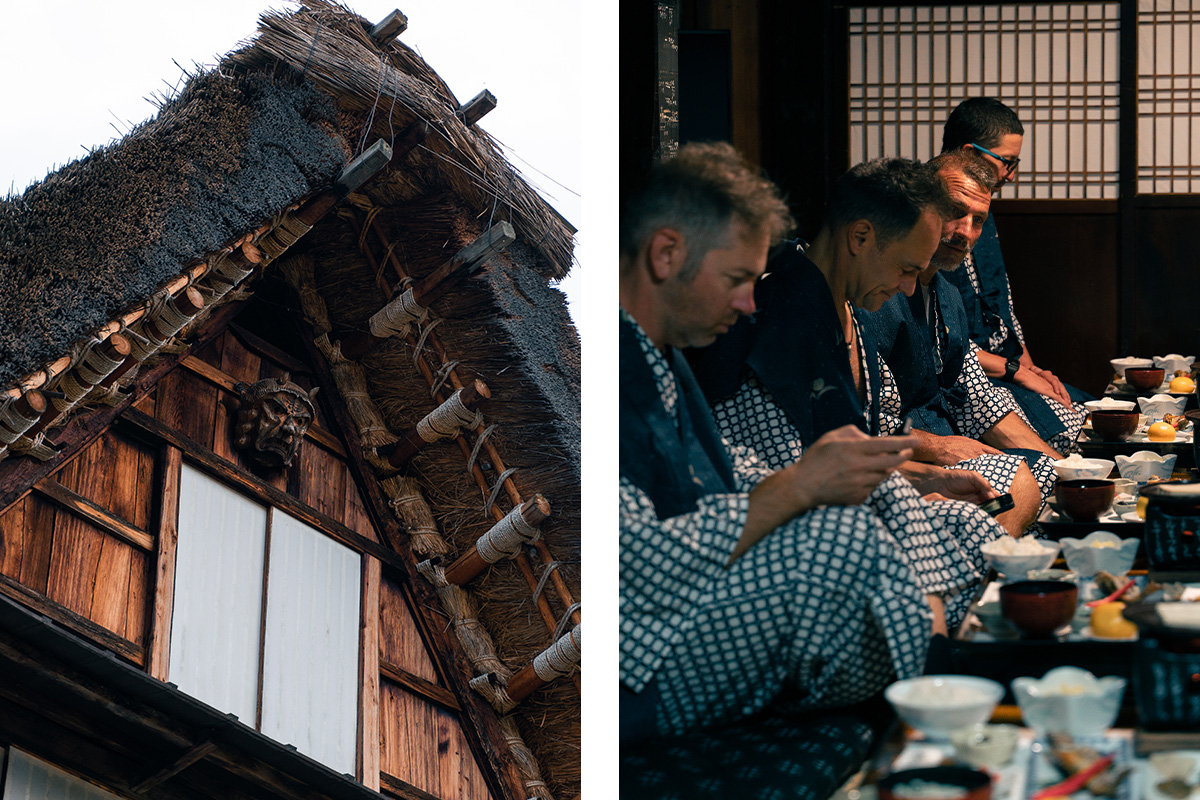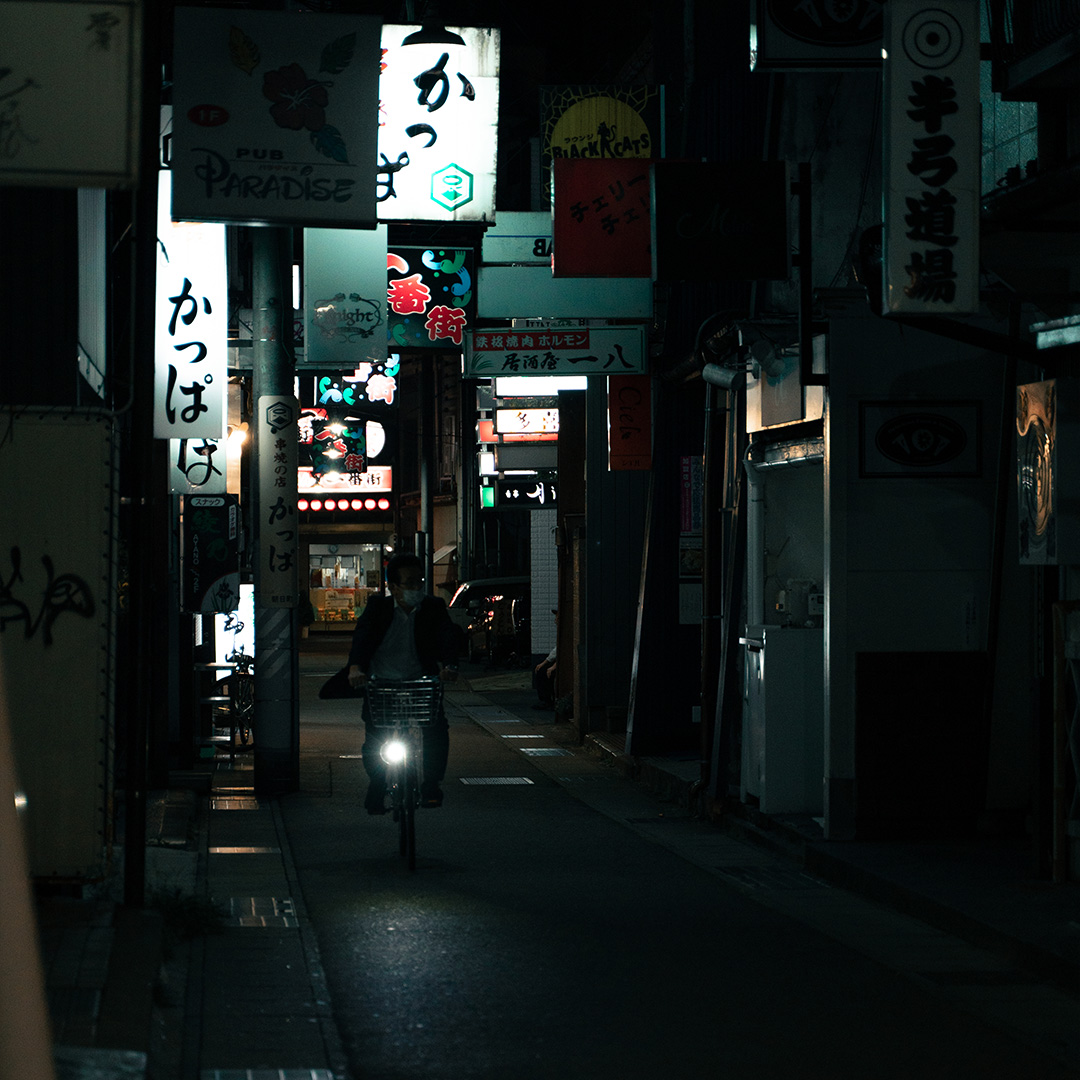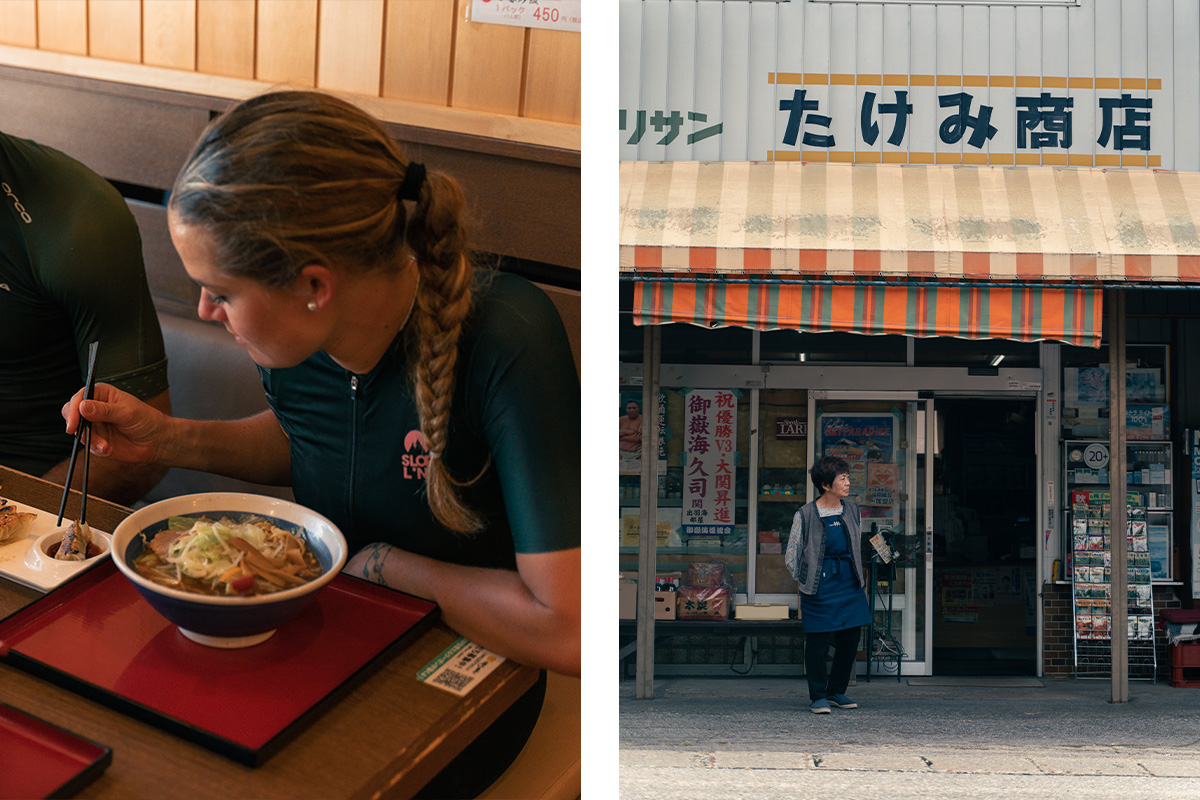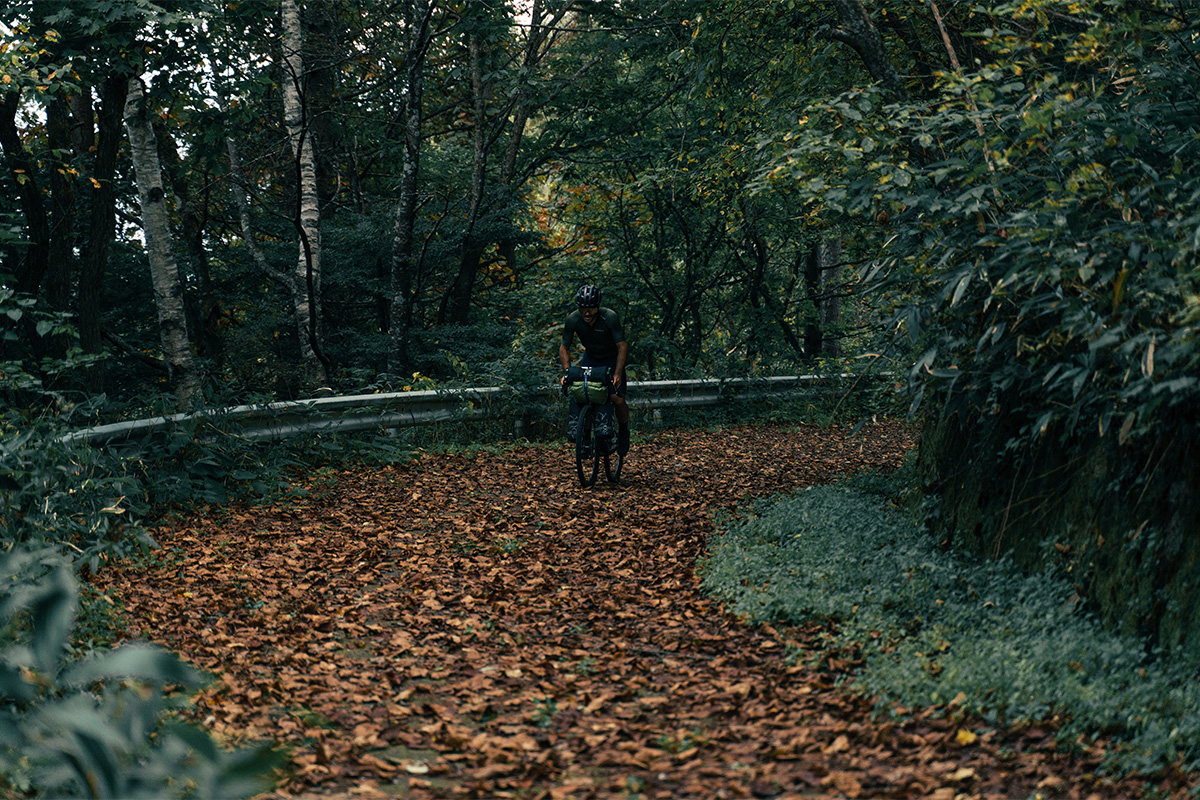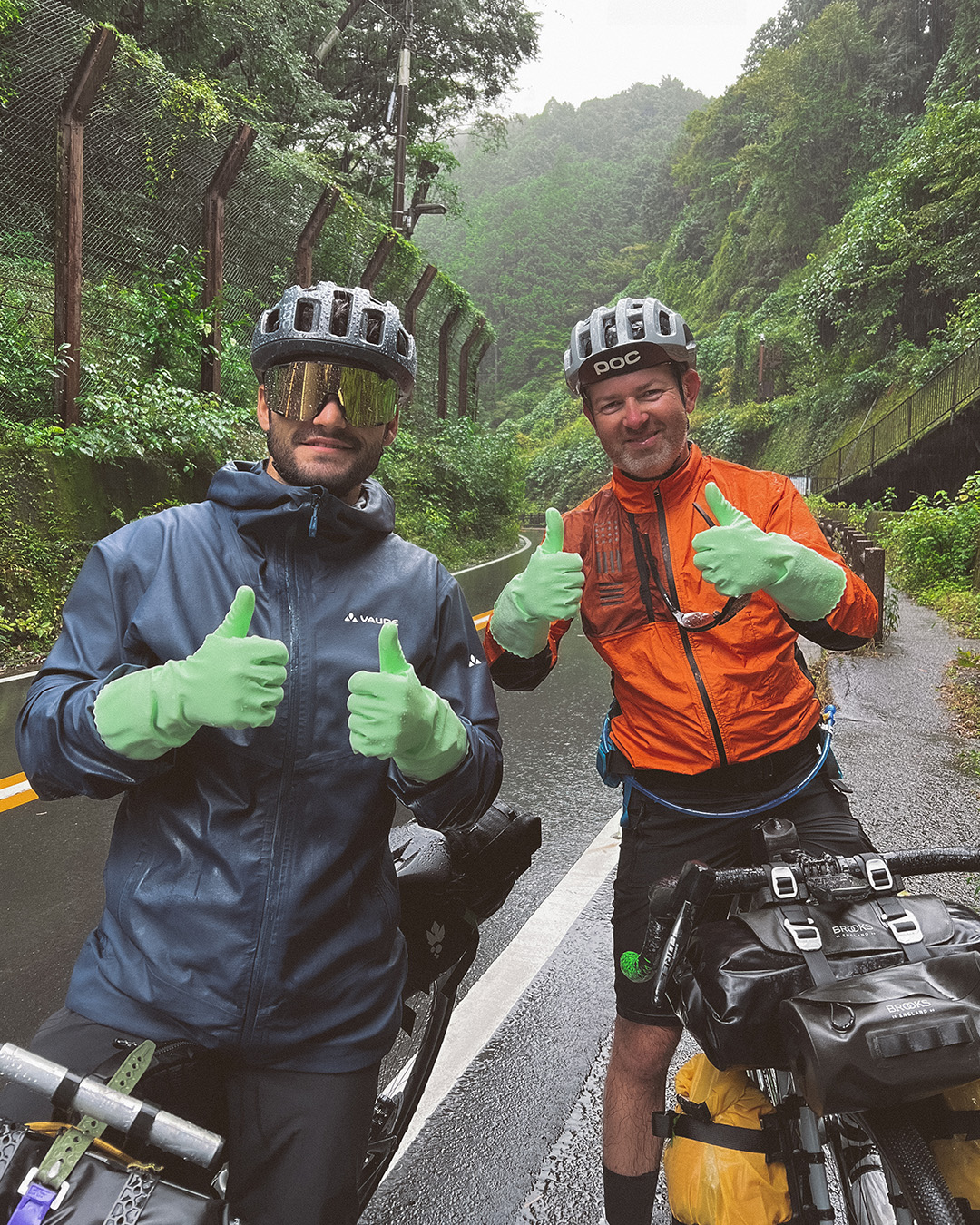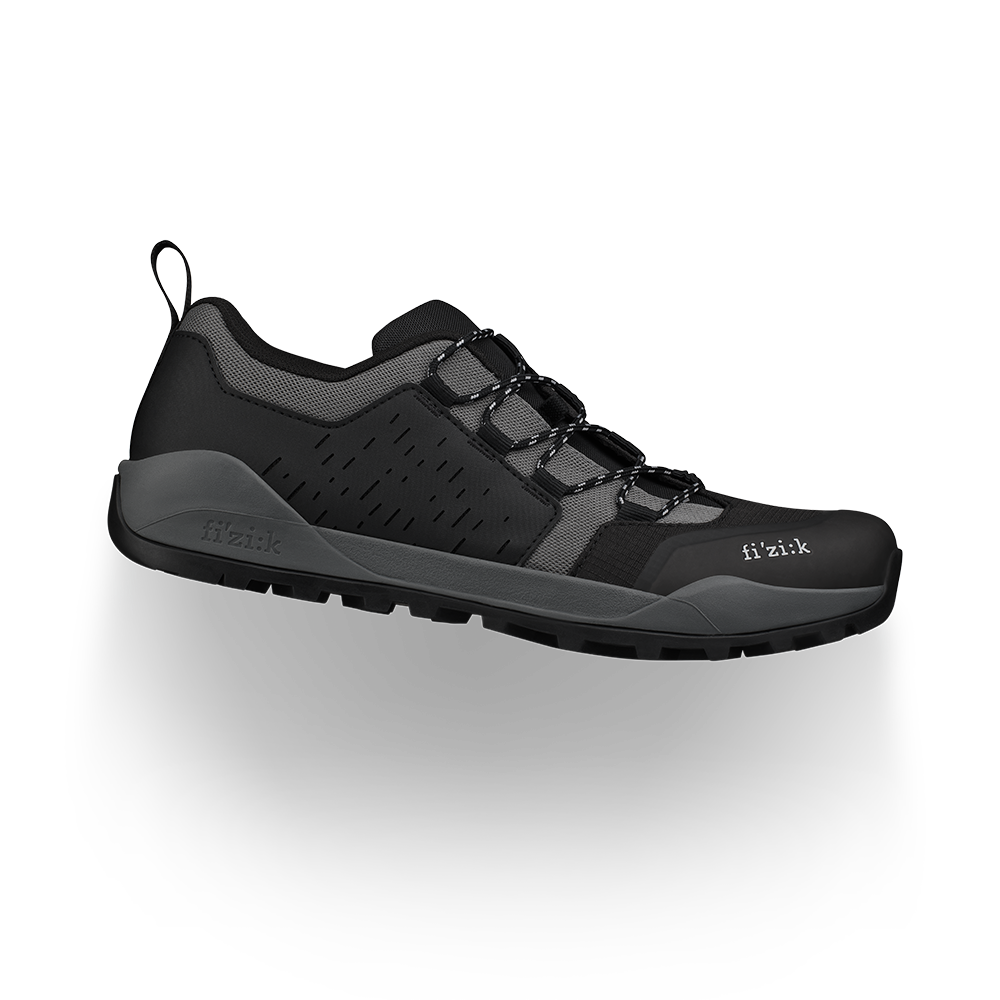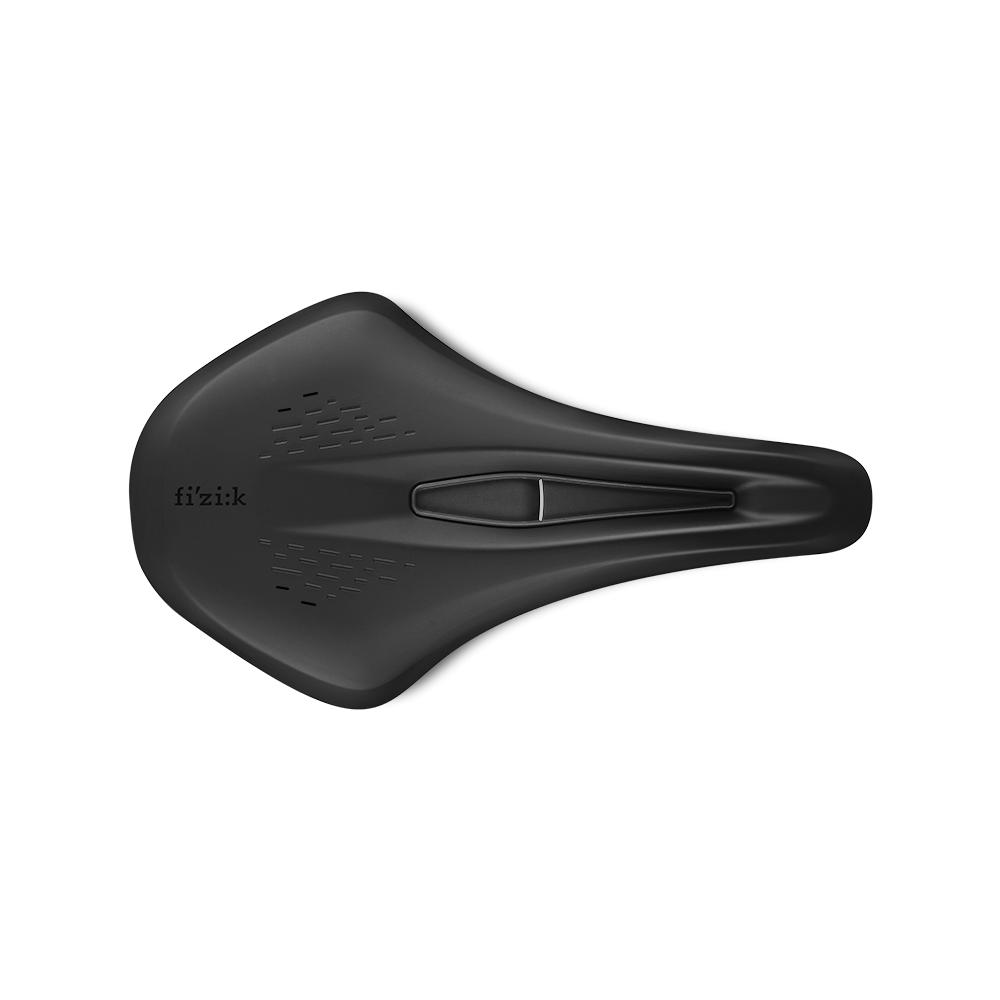There’s Japan. And then there’s Japan by bike. Crossing this island nation on two wheels, one kilometre at a time is, for some, the only way to really experience its winding roads, rural villages, and alluring, ancient culture. Just ask Pol Tarres, who recently joined his fellow fizik ambassador Eleonora Milesi on a ten-day trip across the country organized by PA-Cycling. Dive in for a day-by-day account of their epic bikepacking adventure below.
STAGE 0: Kyoto City Tour
I am not tired of telling everyone that visiting and enjoying a city with a bike is one of the best options possible. Its fast enough to do some KMs within the city but slow enough to stop anywhere when you want to eat or visit something.
So, after assembling the bikes, we went for a city and chill ride to Kyoto, the ancient capital of Japan, a city that has more UNESCO sites than Rome and more three Michelin Star restaurants than London.
We were headed to the Kinkaku-Ji, and we rode through the Kyoto Gyoen National Garden where you can see the Emperor’s residence: the Imperial Palace. The park is the biggest green area of Kyoto, and it’s bike friendly—perfect to start familiarising oneself with Japanese culture.
After that, we walked through Kinkaku-Ji, without bikes, since they are not allowed and there is a 300 Yen entrance fee. If it’s not too crowded, it’s worth the walk. You get to see the Golden Pavilion, an impressive three-story building covered with pure gold leaf, hence the name.
We then rode next to the Kanogawa River to reach, after a small climb, Kiyomizu-dera, a Buddhist temple. It is very cool to go there since, after the climb, you get to see Kyoto City from above, and you can appreciate the contrasts of the buildings.
STAGE 1: Kyoto to Nagahama
The night before, we had packed and got everything ready on the bikes for an early start this morning. We were leaving at 7:30.
Just a few pedal strokes and a couple of turns after leaving the hotel, and you could already feel we were outside of Kyoto. From there, we did an easy 20km climb to reach the highest point of the day. On the downhill, we had an amazing view of Biwa Lake until we reach the “blue line”, a bike lane that goes all around the lake. We followed it for 60km, always riding with the lake on the right, all flat.
We made a mandatory stop at the Shirahige Jinja, a structure that houses the deities of the Shinto religion, and a couple more stops to buy something to eat at convenience stores. We rode past Takashima City and next to Nagahama. At that point, it started to rain, and it didn’t stop until the next day. Luckily, we only had to ride 17km more to reach Takito Keiryuno Takayama Campsite, where we slept in a cabin.
STAGE 2: Nagahama to Neo
We woke up early, had some noodles for breakfast, and we could already feel our legs from the first 120KM of the whole ride. There was no time to warm up since the first big climb of the day started at the campsite, so we took it slow. It was an 11KM and +760M climb, so it was steep: a 7% slope that felt like 12% with all the bags. Even though it was cloudy and some drops fell from the sky, it was not cold, or maybe we were pushing too much and we couldn’t feel it. To be honest, I had a hard time trying to follow Eleonora. She was really strong!!
There were some parts of the road covered in fog, and it created a mystic ambience with the wet tarmac and the strong green colours of the flora. We were warned by our guide that we could have an encounter with some bears and monkeys, and we heard some sounds in the forest, but we didn’t see any.
At the top, we rested a little bit and waited for the rest of the group, then enjoyed the downhill on some rindo and some tarmac. Our guide told us they use the term rindo for the roads that are covered with moss, rocks, leaves, and branches. It is really tricky to ride since you have to be very careful with the hidden rocks and big branches, but it’s very fun when you get the hang of it.
We had lunch in the middle of the ride, next to Fujihashi Castle, built in 1989 to house an exhibition of the village and a planetarium. From there, we had only 30KM left, and we rode some of them next to the Ibi River and stoped at the Tokuyama Dam, an impressive human-made construction that creates electricity.
We kept riding through some tunnels and bridges and ended at the top of the last climb. From there, we enjoyed a very pleasant downhill in the middle of the woods with U-turns and, in some parts, the trees made natural tunnels. It is always nice to end the ride going down.
STAGE 3: Neo to Ikeda
As every day, day three started early. Even though we had almost everything ready, you could always hear our guides, Rob and Willy, shouting the minutes left till our departure. So, while packing the bags, you’d hear: 15 minutes! 10 minutes! 5 minutes! Stage 3 had a huge climb like the day before, but we could warm up with some easy KMs before the hard and steep part. We still suffered, though. It was 6KM at 7.8% with some parts at 16-17%. At the top of the mountain pass, we left the Gifu Prefecture to enter Fukui.
An easy and chill downhill, however there were some parts where the asphalt was broken, and you had to be very carefully not to crash. We reached Ono City, where we stopped for lunch and to regroup with the others. We had some rest before the second part of the stage, and as Eleonora, Antonio, and I rode together, the rest of the group took a detour to avoid one of the two climbs left. We started climbing, and after 20 minutes, we could already see Ono City from above with the typical warm colours from the afternoon light. We were alone; we didn’t see any cars in the next hour.
We went down to Ikeda on a fast and winding road to a wide-open area full of fields. Antonio, Eleonora, and I did some relays to reach Ikeda City, where we stopped at the supermarket to buy some food for dinner and breakfast. Whereas in our minds the stage was finished, we still had to do 5KM to the campsite, and it would have been okay if it weren’t for the last two walls to reach the campsite. It was the worst part of the day. Luckily, a warm onsen (a natural hot spring bathing facility, very popular in the countryside) was waiting for us.
STAGE 4: Ikeda to Ikeda
This was supposed to be the rest day, since we were sleeping in the same place. However Eleonora, Rob (one of the guides) and I decided to ride to the coast to see the Pacific. The most exciting part was that we didn’t carry any of the bags, the bike felt like a feather, super fast and light!
Even though it was an almost 100KM ride, we took it slowly. This was only the fourth day, and we were not even in the middle of the trip. It was a fast start, with a 12KM downhill to Echizen City and another 20KM flat segment to start the climb to pass the mountain and reach the sea. The last part of the climb was short, only 4KM, but steep. From there, we could already see the sea. We did a steep, fast, and dangerous downhill to Michiguchi Town. We rode half an hour next to the coastline, and Eleonora even refreshed her legs at a small beach we stopped at.
After the quick break, we rode straight to Echizen City, and we stopped at a restaurant where we had delicious ramen and recovered enough to climb back to the campsite. That night, we had a BBQ all together, talked a little about life and got to know each other more. At that point, I realised it was a great group, everyone contributing in their own way to the whole experience.
STAGE 5: Ikeda to Hirugano
Stage 5 was more like a transition stage, we did 120KM in six hours. We did a lot of road riding and nothing special. It was nice, though, to push a little bit. The other days I was more focused on nature and the surroundings, and the cycling stayed in the background. So, it was nice for the legs to get a little bit of action. We stopped at the last convenience store to buy some food and arrived at the campsite when it was already dark. A quick and hot shower, dinner with the group and straight to sleep.
STAGE 6: Hirugano to Shirakawa-go
Day six was a bit of breath in the trip; we only rode 40KM, almost all downhill, and the ride ended with a reward: Shirakawa-go. Shirakawa-go is a Japanese mountain settlement that developed unique cultural practices and lifestyles due to geographic and weather conditions, being placed in a mountain region with heavy snowfall in the winter, isolated from others.
The Gassho-zukuri buildings is the first thing you see when you arrive at Shirakawa-go. These houses were built between the 17th century and the beginning of the 20th, and they all have a 60-degree roof slope, so they have the shape of a triangle, so the snow does not accumulate during winter. The structure of the Gassho houses is made only of wood, and they use straw for the rooves.
Little did we knew that we were staying in a very special ryokan (Japanese traditional guesthouse) and after cleaning ourselves, enjoying the onsen, and dressing up with the traditional kimono, we went to the communal dining room. When we opened the door, we saw all ten tables ready for us to eat. The dinner was meticulously prepared, with fish, meat, tofu, beans, mushrooms, bamboo. It was like they did copy-paste of all the meals. It was impressive and also one of the best meals we had. Even Rob, the guide that has been living in Japan for more than 22 years, said it was one of the best meals he had ever eaten in Japan. It was a wonderful night. We slept on the tatami with the futon; it was like we were in a Japanese-themed movie.
STAGE 7: Shirakawago to Takayama City
We woke up and, like the dinner, breakfast was a carefully prepared, Japanese-style breakfast.
We took advantage of the morning light to shoot some pictures with the kimono next to the rice fields and the Gassho-zukuri houses. We finished packing and started our seventh journey.
Again, we had a long 11KM and +750M climb. Even though it was sunny, it was colder than the other days. You could feel the air, and you could tell it was a cold, cold place during winter. At the top, we ate some snacks and put our jackets on. It was cold.
We regrouped with Eleonora, Antonio, and Waldemar and enjoyed the fast downhill. The tarmac was great, and I think we saw just a couple of cars on the whole downhill, so it was not dangerous at all. We made it to the Shimokotori Dam, and riding next to Odori River, we did the last climb of the day. After that point, it was mostly downhill.
Our plan was to have lunch at Hida, just 12KM from Takayama, where we were sleeping, but we were a bit late and almost everything was closed, so, hungrier than ever, we kept pedalling for another half an hour until we found a sushi place in Takayama. It was a very rewarding meal, and actually, it was the first time we ate sushi since we’d arrived in Japan. After that, we went to the hostel where we would be sleeping, then walked around a little bit to see Takayama City.
Even though it was already dark, we could see the narrow streets of the Sanmachi Suji District and a bit of the Sannomachi, the historical centre of the city that is perfectly preserved from the Edo Period (1603-1868). Went back to the hostel and rested for the next day’s early start, again.
STAGE 8: Takayama City to Ina
By this point, every morning, and every time you stood up, you could feel your legs. However, after more than 750KM and +11.500M on a 26KG bike, it was something normal. We started riding at 7:30 am, and we had a meeting point in the middle of the ride—one of the best soba noodle restaurants in the area—which was very cool, because we had 50-something KMs to the restaurant, and it was kind of our motivation because there were no big climbs, but the road was slowly uphill, and you could feel your legs with every pedal stroke. Eleonora and I ended up riding alone, and when we found an abandoned gas station, we stopped to take some pictures, but I think it was more an excuse to rest a little bit. Anyway, we had some fun.
We made it to the restaurant and waited for the others to eat. Rob was right, the best soba noodles we had on the whole trip. After that, we kept going. There was still a big climb at the end of the day, and we wanted to make it before it was dark.
Some ups and downs and beautiful, warm weather, and we made it to the last climb. While the others went through the tunnels, Eleonora, Waldemar, Rob, and I took the fun line, an extra 6KM and +450M to reach a closed road. Rob knew we could go through since he had ridden it the week before. I think we couldn’t have had a better guide, honestly. We went through and found a road covered in leaves, like 100% covered. It was a really cool place; real rindo as Rob would call it.
When the downhill started, you could see some tarmac, but it was tricky with lots of hidden rocks, lots of slippery turns, even some wet parts full of moss. Eventually, Waldemar had a flat tyre, and we stopped to fix it. New tube and kept going, nothing difficult. Turn after turn, the road kept going down until we made it to Ina. Before arriving to the campsite, we did a quick stop at the convenience store to buy dinner and breakfast. It was a long day. I think by 8pm, we were already sleeping.
STAGE 9: Ina to Akaike
It was raining all night. It was raining when we had breakfast. However, it stopped when we started riding. We were lucky. The stage was mainly flat the first 50KM, then a 55KM downhill— yes, 55KM — and you could split the last part in two. The first one was a gentle climb of 15KM, easy-going, and the second one was the one we had to push more with our head than with our legs: 7KM with a 6% slope. It doesn’t seem like much, but after eight straight days of riding 120KM on a 26KG bike, it was something.
It started raining ten minutes before we arrived at the place we had planned to regroup for lunch, so it was nice timing. We ate, and by the end of the meal, the rain had already stopped. We put our jackets on, because it was all wet, there was no sun, and we had more than two hours of downhill, and we went for it.
I think I have never ridden a 50KM downhill; it was a strange feeling to be honest. There were some fast parts, some slow ones, and we ended up in Ghuo, a big city where we bought some food and started the climb. It was nice at first, then the tiredness came to say hi, and things got harder than expected. It started to rain, and Eleonora and I started pushing. We were a bit cold, and we really wanted a hot shower. We pushed for one hour nonstop and made it to the top. There was a tunnel, and when we rode out of the tunnel, it was pouring. It was like the ice bucket challenge. We rode around Lake Shoji and made it to the camping spot, took a shower, had dinner, and went to sleep.
STAGE 10: Akaike to Kawasaki
The last day was supposed to be chill, but I think it was the worst day of my life on a bike. It was “only” a 145KM ride with only +722M, so mainly flat, yes, but the thing is that it was raining ALL DAY. So, we started with our waterproof jackets, waterproof pants, and gloves, and it was all good—for 30 minutes. After that, we were all soaking wet, and it was not that cold. It was something between 14 and 19 degrees all day, however, we were mostly going downhill, and our hands and feet were freezing.
I rode together with Antonio and Eleonora, and we stopped now and then to drink coffee or tea, to eat something and to buy new and dry socks—yes, socks. There was nothing we could do to prevent the water from entering our shoes and socks, so at a certain point, we knew it was going to be like that all day, we embraced it, and kept going. We tried to find different solutions, and all of them failed but one. For our feet, the solution that worked was to put a new plastic bag over our shoes and tighten it to our legs with duct tape, then to put our long pant over that.
For our hands, we bought cleaning rubber gloves, they don’t breathe, but the water can’t get in either, so it worked for us. Even though we looked like we were escaping a laboratory with the bikes, it was the only way we could pedal for six hours in the rain.
Production: ApperStudio
Photo and words: Pol Tarrés Martrat

